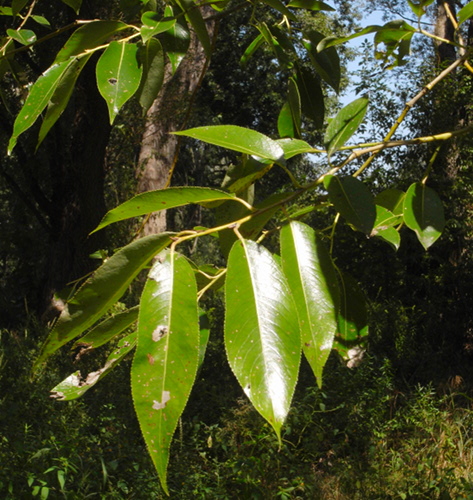
Salix pentandra L. is a boreal willow native to Europe and West Siberia. It is considered to be introduced to about a half of the American states and reported from most counties in Massachusetts: Berkshire, Hampden, Worcester, Middlesex, Essex, Norfolk, Barnstable, Dukes, Nantucket (BE, HD, WO, MI, ES, NO, BA, DU, NA). However, naturalization of this willow in North America appears to be quite improbable. Unlike S. euxina I. V. Belyaeva (S. fragilis auct., part.) and S. × fragilis L., S. pentandra has twigs that are not easily broken off. Besides, in S. pentandra, the ability of twigs to root is low (0-15%, according to Belyaeva et al. 2006). While it is possible to propagate S. pentandra from softwood cuttings, in natural settings this willow is known to regenerate only from seeds. In North America it is known only as female (pistillate) plants (Argus 2010), so the sexual reproduction is excluded. It is difficult to imagine that under these circumstances it could escape from cultivation.
Therefore, I consider occurrences of S. pentandra in North America to be a myth and presume all records for this willow as either collections from cultivated plants or misidentifications—mostly of the hybrid S. pentandra × S. euxina (the latter formerly called S. fragilis). Such hybrids must have been favored for cultivation, as they are easily propagated vegetatively. In the European literature, they are named S. × meyeriana Rostk. ex Willd., but their existence has been ignored in the recent American literature. It is, however, noteworthy that some old North American herbarium samples now labeled S. pentandra also carry older labels 'S. pentandra × S. fragilis' (the latter, from now on, is to be called S. euxina, see Belyaeva 2009).
Upon examining about fifty herbarium samples from New England identified as S. pentandra, I came to the conclusion that most of them were S. × meyeriana. Those samples most reliably assigned to S. × meyeriana originate from the following Massachusetts counties: BE, WO, MI, ES, NO, BA, DU, and additionally from Hampshire (cultivated), Suffolk (perhaps cultivated), and Plymouth (cultivated). My identification of samples from Hampden and Nantucket is less reliable: it is not always possible to distinguish S. pentandra from S. × meyeriana using the existing herbarium material.

So far I have been able to locate in New England only a single living willow formerly identified as S. pentandra—the one growing in the Arnold Arboretum of Harvard University (accession 95-1990). Even this cultivated plant can hardly be a pure S. pentandra. This is a rather young tree, an asexual propagation of an older Arboretum accession 503-33 originating (as cuttings) from Berlin Botanic Garden. Having lustrous branchlets and broad, dark-green, very shiny leaves, it does look like a true S. pentandra, yet from the first glance something about this tree seemed vaguely not quite right, as compared to S. pentandra in Europe. An examination showed that its twigs were rather brittle (a character of S. × fragilis or S. × meyeriana). When placed in water, the twig rooted readily, even without a hormone treatment. Most importantly, the outer primordial leaves in examined buds had long trichomes across the apical half of the abaxial surface, a character alien to S. pentandra (Skvortsov 1955, 1960, 1968, 1999, etc.).
Therefore, I consider the Arnold Arboretum accession 95-1990 to be a hybrid of S. pentandra, most probably with S. euxina or else with a S. × fragilis phenetically approaching S. euxina. Since even those plants cultivated in arboreta under the name S. pentandra may prove to be hybrids, for the time being I would remove S. pentandra from the list of New England willows and consider removing it from the list of the US willows until it is proved otherwise.
List of herbarium samples examined in July-September 2010 identified as S. × meyeriana.
This plant, growing in Arnold Arboretum, is a male tree, while all known herbarium samples of 'S. pentandra' from North America are pistillate (female) plants (photos added 28 May 2011).
A. Zinovjev (30 Dec 2010 - 28 May 2011)
Illustrations
Extended links in the text to multiple images are implemented using CSS and Javascript; if Javascript is disabled, only one image per link will be open in a separate window. Links to all illustrations (pertaining to the same S. x meyeriana from the Arnold Arboretum) are provided below as a list: